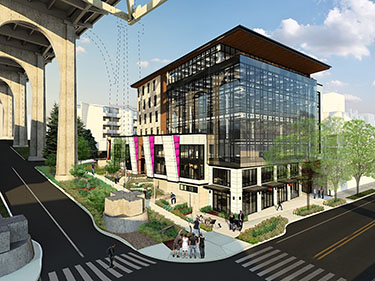|
Subscribe / Renew |
|
|
Contact Us |
|
| ► Subscribe to our Free Weekly Newsletter | |
| home | Welcome, sign in or click here to subscribe. | login |
Architecture & Engineering
| |
July 12, 2017
A facade that helps treat stormwater
Weber Thompson, Alexandra Ramsden of Rushing and Jennifer Barnes of 55-5 Consulting won an honorable mention in a biomimicry design competition for a conceptual project called RainBellows.
The competition was put on by Eleven Magazine.
The project was developed by Weber Thompson's Landscape Studio, Ramsden and Barnes as part of their work on the Seattle Urban Greenprint Project.
Weber Thompson said RainBellows was inspired by the ice plant, which has specialized cellular layers that filter, store and reuse water.
RainBellows expands the exterior skin of a building to clean and store stormwater for reuse. A flexible water storage liner is contained within the wall system. When there's no water in the system, the liner is hidden behind cladding. When it rains, the facade expands via a hinge along the bottom and the liner is revealed. Water is held in the liner until it is needed.
The basis for the design grew out of working on a project called Watershed, a highly-sustainable seven-story office building planned for 900 N. 34th. in Seattle. Watershed will reuse water in the building, and its bioswales will clean runoff from the nearby Aurora Bridge.
The concept for RainBellows addresses water from occupied roofs of the project that the health code prohibits from being reused.
RainBellows will not be used in Watershed, according to Weber Thompson, the architect and landscape architect for the project, and there are no plans for using it on future projects.
RainBellows was among 71 conceptual projects in the competition. Proposals ranged from fashion and architecture to product design and urban systems.
Eleven Magazine is an architecture-design-lifestyle magazine dedicated to innovative design.
The Greenprint Project looks at ways to strengthen urban ecological systems through biomimicry-based design guidelines.



